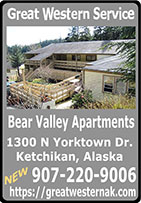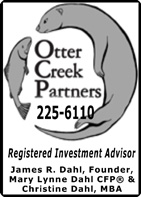

















 Contact Contact 
 Webmail
Letters Webmail
Letters
 News Tips News Tips
 Copyright Info Copyright Info
 Archives Archives
Quick News
Search
 Alaska Alaska
 Ketchikan Ketchikan
 SE Alaska SE Alaska
Columns
- Articles
 Dave Kiffer Dave Kiffer
 Money Matters Money Matters
Historical
Ketchikan
 June Allen June Allen
 Dave
Kiffer Dave
Kiffer
 Louise
B. Harrington Louise
B. Harrington
Ketchikan
Arts & Events
 Ketchikan
Arts Ketchikan
Arts
 Ketchikan
Museums Ketchikan
Museums
 KTN Public
Library KTN Public
Library
Sports
 Ketchikan Links Ketchikan Links
Public Records
 FAA Accident Reports FAA Accident Reports
 NTSB
Accident Reports NTSB
Accident Reports
 Court Calendar Court Calendar
 Recent Filings & Case Dispositions Recent Filings & Case Dispositions
 Court Records Search Court Records Search
 Wanted:
Absconders Wanted:
Absconders
 Sex Offender Reg. Sex Offender Reg.
 Public Notices Public Notices
 AST Daily Dispatch AST Daily Dispatch
 KTN
Police Reports KTN
Police Reports
 Juneau Police Reports Juneau Police Reports
Weather,
Webcams
 Today's
Forecast Today's
Forecast
 KTN
Weather Data KTN
Weather Data
 AK
Weather Map AK
Weather Map
 AK Weathercams AK Weathercams
 AK Earthquakes AK Earthquakes
TV Guide
 Ketchikan Ketchikan
Ketchikan
Phone Book
 Yellow
Pages Yellow
Pages
 White
Pages White
Pages
Government
Links
 Local Government Local Government
 State & National State & National

|
|

Sunday
July 09, 2017

|
Ketchikan's Fireworks 2017
Front Page Feature Photo By KENNON CALIWANAGAN ©2017
Alaska: Women earn an average of 68 percent of what men make in Alaska - The average woman who worked in Alaska in 2015 earned $34,333, and there was nearly a 50 percent chance she worked in health care or in state or local government. She also made 68 percent of what the average Alaska man earned, according to Karinne Wiebold an economist for the Alaska Department of Labor and Workforce Development.
In 2015, nearly 167,000 women worked in Alaska and earned $5.7 billion. However, according to Wiebold, men earn more in nearly 80 percent of Alaska’s occupations and at every age and educational level, even though men and women participate in the workforce at nearly equal rates and work the same number of quarters per year. Forty-eight percent of the state’s workers were women in 2015, but they made 38 percent of total wages.
In a recent article published in the Alaska Economic Trends magazine, Wiebold reported that women’s workforce presence and share of total wages have both increased slightly since the late 1980s, when women were 47 percent of workers and earned 35 percent of wages. But over the past decade, both percentages have stayed about the same, with wages hovering around 38 percent and the percent of total workers varying by just half a percentage point.
The earnings ratio, or women’s wages in Alaska as a percent of men’s, has grown somewhat over time reported Wiebold an economist. During the late 1980s, when Alaska was recovering from a significant recession, wage parity was at a low of 62 percent. That gap narrowed during the 1990s, to between 65 and 66 percent, and it continued to shrink into the 21st century.
Wiebold's article’s data did not measure the reasons for the Alaska's gender wage gap. She suggested there were a variety of factors likely influence the disparity in wages, including job experience, training, education, hours worked, choice of occupation or industry, and current and historical discrimination - but the degree to which those factors affect the gap was outside her article’s scope.
Gap smallest in urban areas
While women are 48 percent of the workforce statewide, the percentage varies considerably by region wrote Wiebold.
The percentages in some of the most populated and urban areas - Anchorage, Fairbanks, and the Gulf Coast - are around 49 percent.
Women earn a slightly higher percentage of wages than the statewide 38 percent in the two most urban areas: Anchorage (41 percent) and Fairbanks (40 percent). Those cities have a significant number of high-paying private occupations as well as state and local government jobs, which have a smaller wage gap.
According to data presented by Wiebold, in Southeast Alaska, women make up 50 percent of the workforce and how their pay measures up differs by location such as:
- in Ketchikan, women make up 41 percent of the workforce earning an average annual wage of $24,385. Women in Ketchikan earn an average of 75 percent of what a man makes in Ketchikan.
- In Sitka, women make up 52 percent of the workforce earning an average annual wage of $31,421 and earn an average of 84 percent of what a man makes in Sitka.
- In Wrangell, women make up 54 percent of the workforce earning an average annual wage of $26,594. Wrangell women earn an average of 84 percent of what a man makes in Wrangell.
- in Juneau, women make up 49 percent of the workforce earning an average annual wage of $36,748 and earn an average of 84 percent of what a man makes in Juneau.
- Prince of Wales - Hyder women make up 47 percent of the workforce earning an average annual wage of $24,850 and earn an average of 79 percent of what a man makes in POW-Hyder.
The Gulf Coast Region’s workforce is 49 percent female, but women earn just 37 percent of total wages reported Wiebold. The area is notable for its high-paying jobs in oil and gas, the industry in which women are least likely to work.
Rural areas with remote work sites, such as the Northern and Rural Interior regions, have higher percentages of men in the workforce according to Wiebold. Mining, oil extrac on, and oilfield services workers are predominantly men, and those jobs are also high-wage. For example, the North Slope Borough, where women earn 59 percent of what men make on average, has a workforce that’s just 20 percent women. Note, however, that the women who work in the North Slope Borough have the highest average wages in the state. - More...
Sunday AM - July 09, 2017
|
|
Fish Factor: Robotic Workforce for Seafood Processing Industry By LAINE WELCH - Robots are cutting up snow crabs in Canada, a sign of things to come in the seafood processing industry.
Overall, seafood processing has a relatively small robotic involvement compared to other sectors. Robots have yet to make it into any of Alaska’s 176 fish processing shops, but the lure of reduced production costs, increased fish quality and crews of worker-bots is turning the tide.
The CBC reports that the world’s first crab plant robot began work this spring in a plastic chamber about the size of a shipping container in remote Newfoundland.The robot receives crabs on a conveyor belt and quickly dismembers each with a buzzing blade. The crab legs then tumble into a tub below, all sorted, sectioned and ready to go.
Another robot in the works will soon shuck all the meat from the crab for a better financial return.
“Instead of sending our crab out as sections with the meat in the shell, we thought we could attract a higher price if we sold the meat instead,” said Bob Verge, director of the Canadian Centre for Fisheries Innovation where the crab cutting robots were created.
The meat extraction used to be done by hand in Newfoundland plants, but years ago that job shifted to China where the labor is cheaper.
Bringing that step back to Newfoundland, Verge said, would make more money for plant operators and get more value from the resource.
And for the first time robots also are deboning and filleting cod fish on Norwegian processing lines. New Atlas reports that a machine called APRICOT (automatic pin-bone removal in cod and whitefish) is using x-ray technology to locate the tiny pin bones in the fish and neatly trim them away using water jets.
“Unlike farmed salmon, which are similar in size and shape and therefore suitable for automated machine filleting, the variability of wild-caught white fish such as cod has kept filleting of these fish a manual affair,” said a spokesman for Marel of Iceland, the world’s biggest fish processing equipment manufacturer.
The APRICOT robot system is expected to be ready for commercial use by year’s end.
As the U.S. seafood industry becomes more reliant on products from aquaculture, equipment makers are designing machines for processing those more predictable fish.
Complete lines are now operating, for example, where whole farmed salmon enter at one end and portions ready-packed for supermarkets leave at the other.
Norwegian processor Nordlaks described the Marel-made system as “a seamless flow of salmon portions without manual handling.”
“A robot places the fish pieces directly into the packaging and the system reduces labor costs by up to 20 percent,” a spokesman said.
Robot makers say they are hoping their machines will help solve workforce problems in fish plants caused by changing demographics and global markets, and labor shortages. In the near future, they predict more highly skilled humans will work on sophisticated machines and computers, and not on the slime lines.
“If we are going to attract young people we need better jobs, not more jobs” said the crab robot’s Bob Verge. “We have to offer them a better deal. We’ve already demonstrated this technology to young people and they are very impressed with it. They say I’d like to do this.”
Robots also are making inroads into the big freezers that hold the bulk of Alaska’s seafood before it goes to markets.
A Netherlands company called NewCold has partnered with Trident Seafoods to build one of the nation’s biggest cold storage warehouses outside of Tacoma. WA. The companies call it “a solution for increased labor, land and energy costs.”
Seafood products will be stored on a robot-run system of tiered trollies and racks in low oxygen and in pitch dark, and then transported to the loading area by conveyors and worker-bots.
When the $50 million project is completed at year’s end, it will have storage capacity of more than 25 million cubic feet. - More...
Sunday AM - July 09, 2017
|
|
Alaska: Special Session Compromise Proposed; End Cash Credits Now - The Alaska House Majority Coalition on Friday communicated a proposed compromise to the Alaska Senate Majority to address oil tax credit reform, which is the subject of the ongoing Second Special Session of the 30th Alaska State Legislature.
Alaska House Majority Coalition members are supporingt changes to House Bill 111 to end the practice of paying oil companies cash subsidies for certain tax credits. This is expected to save the State of Alaska an estimated $1.5 billion over the next ten years. As part of the compromise, other proposed changes to the current oil tax regime would be discussed during the interim with the hope of reaching compromise on a comprehensive reform bill during next year’s regular legislative session.
“We agree with our Senate colleagues that we should move forward on what we agree on, which is ending cash credits. Paying cash to the oil industry during a fiscal crisis is bad public policy,” said House Resources Committee Co-chair Rep. Geran Tarr (D-Anchorage), Chair of the House Bill 111 Conference Committee.
Tarr said, “The members of our Coalition continue to support broader oil tax reforms but in the spirit of compromise we can accept a simple reform of the cash credits and will push for a working group to work with our consultants to develop a new tax and incentive program.” - More...
Sunday AM - July 09, 2017
Alaska: Marches of the Walking Dead Make Health Care Statements - Alaska residents took to the streets Saturday in downtown Anchorage to ask Senators Lisa Murkowski and Dan Sullivan to do the right thing and vote “NO” on the senate healthcare bill under consideration. The March of the Walking Dead highlighted the life and death reality of this vote for Alaskan citizens from all walks of life. Supporters of the March say Alaska would be hard-hit by the proposed senate healthcare bill with an estimated $2,200 - $2,300 increase in health insurance premiums -- nearly double the next highest projection in the country.
Oli Schiess, a former Marine and resident of Eagle River, said, “This bill hurts Alaska more than any other state. It leaves veterans in the dust and it hurts so many. One cannot expect to take so much away from so many and have society not suffer as a whole.
Another attendee at Saturday’s event, Malena Marvin, a cancer survivor and small business owner from the Southeast Alaska town of Petersburg attended the event in Anchorage after a surgery earlier this week, agreed and stated, “We have to pull off the blinders and see that the Republican healthcare ‘repeal and replace’ would be a self-destructing circus act, if only we were willing to unite and fight for the common sense alternative.”
The March of the Walking Dead in Anchorage Saturday followed a rally in Fairbanks on July 6th where Santa Claus, a North Pole city council member, asked Alaska's Senators to think about all the children in Alaska who rely on Medicaid when they vote on this bill. - More...
Sunday AM - July 09, 2017 |
|
 |
PHIL KERPEN: Democrats Will Be Tested as Menendez Finally Stands Trial - On April 1, 2015 U.S. Senator Robert Menendez and codefendant Salomon Melgen were indicted on 22 felony counts of fraud, bribery, and related offenses.Now, finally, after over two years of Menendez serving as a member in good standing of the Senate Democratic Caucus while under indictment, the trial is set to begin.A last-ditch attempt for yet another delay was rejected by Judge William Walls and the trial date is September 6, 2017.
Menendez delayed the trial by more than two years by arguing that his efforts to intercede on behalf of Melgen with respect to visas for his girlfriends, a Medicare billing fraud investigation, and a Dominican port security contract were all official Senate actions that were protected by the Constitution's speech and debate clause.That argument failed at the district court and on appeal to the Third Circuit; Menendez appealed to the Supreme Court but they declined to take it up.
In the meantime, Melgen has been convicted of 67 counts of Medicare fraud for a scheme that looted $105 million from taxpayers and faces 15 to 20 years in prison if his sentence is not reduced.Melgen allegedly bribed Menendez to scuttle an investigation into precisely this fraud scheme, one of the central allegations in the upcoming trial.
The media, which has largely ignored the whole sordid affair since the initial burst of coverage around the indictment, will soon be forced to confront the daily spectacle of a sitting U.S. senator standing trial.Democratic corruption will come under a microscope. - More...
Sunday AM - July 09, 2017
 |
MARIA FOTOPOULOS: On World Population Day Only Growing Numbers Ahead - Included in the signoff for my emails is reference to the 58 percent decimation of wildlife in just the last four decades, driven largely by loss of habitat due to increasing human demands as world population continues its upward trajectory.
According to the "World Population Prospects: The 2017 Revision," published recently by the UN Department of Economic and Social Affairs, we add 83 million people annually. By 2030, Earth's population will be 8.6 billion. Then, 9.8 billion in 2050 and 11.2 billion in 2100. And, these estimates assume that fertility levels will continue to decline. For some perspective, world population in 1974 was 4 billion, so we've doubled in size in not even a lifetime ---- 55 years.
Nearly 10 billion people on Planet Earth in just another 30 years. We all should be concerned. Very concerned. Our world "thought leaders" in government, business and media should be concerned, because the negative implications of this growth are many and frightening. For natural resources, food, health, safety, infrastructure, work, biodiversity.
Yet, we don't see lead stories in the press about the benefits of stabilizing population; it's not a topic on talk shows and broadcast news. And too many in business have moved more into the fantasy realm (perhaps as a way to take the focus off of their companies that don't actually make money) versus solving real-world problems. Elon Musk is more concerned about squandering billions of dollars in a fantasy of colonizing Mars than fixing Earth-bound problems, while Jeff Bezos is infatuated with drones. - More...
Sunday AM - July 09, 1017
|

Editorial Cartoon: DNC accountability
By Adam Zyglis ©2017, The Buffalo News
Distributed to subscribers for publication by Cagle Cartoons, Inc.
|
Fact versus fiction By Rep. Dan Ortiz - As an elected official, it’s my responsibility to keep Alaskans informed with factual and relevant information about the issues that affect them. As I write I’m busy working for you up in Juneau, so here’s a quick rundown of fact versus fiction. - More...
Sunday AM - July 09, 2017
Please Be A Responsible Pet Owner By William J. Miller - We have tried to be good neighbors and have politely asked our neighbor to keep their dog out of our yard as it has unfortunately gotten into the habit of depositing poop outside the entry to our home. The last encounter with the dog resulted in baring of teeth and challenging us. I’m pretty sure there is a leash law in the borough and although we are avid pet lovers and owners, we are at the point of contention in our household as my wife wants to file a formal complaint with animal control but I am reluctant since it will no doubt drive a permanent wedge between neighbors. - More..
Sunday AM - July 09, 2017
Gilmore Hotel By Kitty Meredith - My mother, Mary Patricia Gilmore Fox, told me that she was born in the Gilmore Hotel on October 23, 1905. Her parents, Peter Francis Gilmore and Mary Eleanor Fitzmaurice Gilmore and my mother moved shortly after into a large Victorian house they had built on Grant St., across from Ketchikan School. The house was called “the Irish Castle”. On the front of the house, high up on the tower area, was a large green shamrock. - More...
Sunday Am - July 09, 2017
Tribute to Sol Atkinson By A. M. Johnson - Regarding the tribute to Sol Atkinson, I met Sol during my careers in the early 70's where Metlakatla was involved. Sol must have retired recently to this introduction. He was a standout personality on the first meet without knowing of his military history. - More...
Sunday AM - July 09, 2017
Neutralize North Korean Threat By Donald Moskowitz - North Korea continues to expand its nuclear weapons program and is making progress in developing an intercontinental ballistic missile (ICBM) capable of reaching the Western U.S. It is working on miniaturizing nuclear weapons to fit on ICBMs by early 2018, and it threatens to attack the U.S. with nuclear warheads. - More...
Sunday AM - July 09, 2017
Traffic suggestions By A. M. Johnson - Nothing better to do than reflect on a couple of issues related to Ketchikan traffic. Our traffic due to restrictive nature of our streets and roads, should be rated at a near 10 on a scale of 1-10 with 10 being the most taxing. - More...
Thursday PM - June 29, 2017
A Call to Leadership By Randall Hoffbeck - When, after being in session for 160 days, I began to hear both the House and Senate leadership talking about passing just a budget and going home, I was reminded of a meeting I had last summer with a professor from the University of Potsdam. - More...
Thursday PM - June 29, 2017
Health Care By Ray Metcalfe - By week's end we will know if either of our Alaskan US Senators are willing to concoct an excuse to throw 100,000 Alaskans under the bus for the opportunity to stay in Senator McConnell's good graces. Oddly enough, the same vote will deliver a giant tax break to wealthy families, their families included... And by the way; have you ever wondered why the same industry complaining about the exorbitant costs of insuring their workers also pay lobbyists to lobby against Bernie Sanders proposal to lift the burden from their shoulders with better quality, lower deductible coverage through a single payer system? Bernie wants to expand Medicare to cover every American of every age through Medicare. - More...
Thursday PM - June 29, 2017
Protect Medicaid By David G. Katzeek - One day, we will tell future generations of our choice. Did we help our neighbors when they were sick, or did we ignore their needs? This is the question before all Alaskans when it comes to Medicaid. - More...
Tuesday AM - June 27, 2017
Open Letter: Rep. Jonathan S. Kreiss-Tomkins By Gregg Parsley - Several of us in the Southeast Alaska mariculture industry would like you to look into what it would take to begin the process for Federal Disaster Relief funds for our oyster industry here in Southeast Alaska due to Paralytic Shellfish Poisoning (PSP). We, Shikat Bay Oysters, have been shutdown for going on 4 weeks with no relief in sight, we have lost to date over $25,000 and once our parts per unit (ppu) numbers fall below the 80 ppu number we will still have to wait another two weeks before we are able to put oysters back into commerce. I can see us, Shikat Bay Oysters, loosing in excess of $40,000 due to this unusually early and unseasonably PSP outbreak. - More...
Tuesday AM - June 27, 2017
RE: Use for Taku By Kay Taylor - The idea of the Ferry Taku being used for lodging for our representatives to save money is great. We need to stop frittering away dollars. If the Ferry system is good enough for us then it is good enough for our representatives. Moving it to Juneau for housing would solve two problems. We need to cut down on per diem for our traveling representatives. - More...
Tuesday AM - June 27, 2017
Living Within Means By Lance Clark - I think Senator Gardner shows us exactly what the fiscal problem is. Living within our means is not a foreign idea to her, it's an evil one! To be good people we have to always spend more than we have. I don't know her personally but her way of thinking sounds insane. - More...
Tuesday AM - June 27, 2017
 Webmail your letter or Webmail your letter or
 Email Your Letter To: editor@sitnews.us Email Your Letter To: editor@sitnews.us
|
Articles &
photographs that appear in SitNews may be protected by copyright
and may not be reprinted or redistributed without written permission
from and payment of required fees to the proper sources.
E-mail your news &
photos to editor@sitnews.us
Photographers choosing to submit photographs for publication to SitNews are in doing so, granting their permission for publication and for archiving. SitNews does not sell photographs. All requests for purchasing a photograph will be emailed to the photographer.
|
|





 Weekly Specials.
Weekly Specials.
Coming Soon Online Shopping for Pickup or Delivery. |











The Local Paper is
available online.
Click here for this week's printed edition.

|
|
|
![]() Contact
Contact ![]()
![]() Webmail
Letters
Webmail
Letters![]()
![]() News Tips
News Tips![]()
![]() Copyright Info
Copyright Info![]() Archives
Archives![]() Alaska
Alaska![]() Ketchikan
Ketchikan![]() SE Alaska
SE Alaska![]() Dave Kiffer
Dave Kiffer![]() Money Matters
Money Matters ![]() June Allen
June Allen![]() Dave
Kiffer
Dave
Kiffer![]() Louise
B. Harrington
Louise
B. Harrington![]() Ketchikan
Arts
Ketchikan
Arts![]() Ketchikan
Museums
Ketchikan
Museums![]() KTN Public
Library
KTN Public
Library![]() Ketchikan Links
Ketchikan Links![]() FAA Accident Reports
FAA Accident Reports ![]() NTSB
Accident Reports
NTSB
Accident Reports![]() Court Calendar
Court Calendar![]() Recent Filings & Case Dispositions
Recent Filings & Case Dispositions ![]() Court Records Search
Court Records Search![]() Wanted:
Absconders
Wanted:
Absconders![]() Sex Offender Reg.
Sex Offender Reg.![]() Public Notices
Public Notices![]() AST Daily Dispatch
AST Daily Dispatch![]() KTN
Police Reports
KTN
Police Reports![]() Juneau Police Reports
Juneau Police Reports ![]() Today's
Forecast
Today's
Forecast![]() KTN
Weather Data
KTN
Weather Data![]() AK
Weather Map
AK
Weather Map![]() AK Weathercams
AK Weathercams![]() AK Earthquakes
AK Earthquakes![]() Ketchikan
Ketchikan![]() Yellow
Pages
Yellow
Pages![]() White
Pages
White
Pages![]() Local Government
Local Government![]() State & National
State & National











































